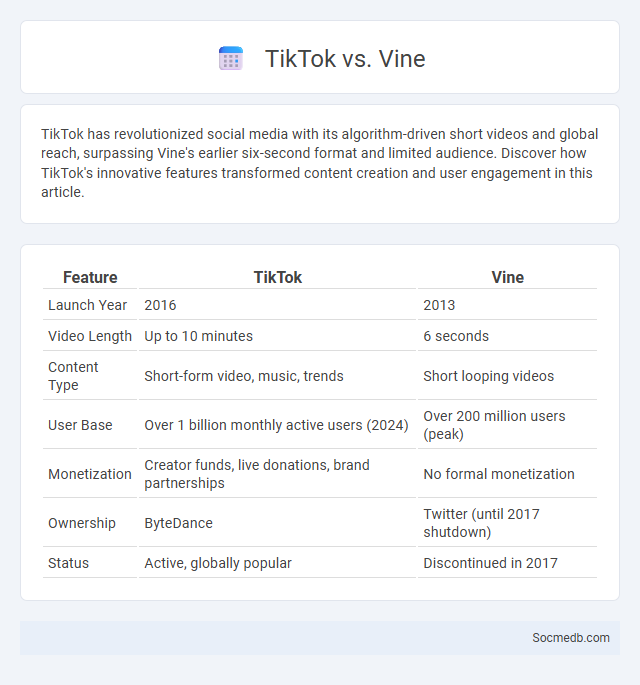
Photo illustration: TikTok vs Vine
TikTok has revolutionized social media with its algorithm-driven short videos and global reach, surpassing Vine's earlier six-second format and limited audience. Discover how TikTok's innovative features transformed content creation and user engagement in this article.
Table of Comparison
| Feature | TikTok | Vine |
|---|---|---|
| Launch Year | 2016 | 2013 |
| Video Length | Up to 10 minutes | 6 seconds |
| Content Type | Short-form video, music, trends | Short looping videos |
| User Base | Over 1 billion monthly active users (2024) | Over 200 million users (peak) |
| Monetization | Creator funds, live donations, brand partnerships | No formal monetization |
| Ownership | ByteDance | Twitter (until 2017 shutdown) |
| Status | Active, globally popular | Discontinued in 2017 |
Introduction to Short-Form Video Platforms
Short-form video platforms like TikTok, Instagram Reels, and YouTube Shorts dominate social media by offering engaging, bite-sized content typically lasting from 15 to 60 seconds. These platforms utilize advanced algorithms to personalize user feeds, driving high engagement and content virality. Marketers leverage short-form videos for brand awareness and sales conversions due to their rapid consumption and shareability.
The Rise and Fall of Vine
Vine revolutionized short-form video content by popularizing six-second looping clips, attracting millions of creators and viewers within its peak years (2013-2016). Despite its innovative format and significant cultural impact, competition from platforms like Instagram and Snapchat, combined with monetization challenges, led to Vine's decline and eventual shutdown in early 2017. The rise and fall of Vine highlight the volatile nature of social media platforms and the critical need for sustainable business models in digital content creation.
TikTok’s Meteoric Growth
TikTok's meteoric growth has transformed the social media landscape, attracting over 1 billion active users worldwide by 2024. Its unique algorithm delivers highly personalized content, boosting user engagement and session times exponentially. To capitalize on this trend, you should leverage TikTok's dynamic platform to reach diverse audiences and drive brand visibility effectively.
Core Features Comparison
Core features of social media platforms include content sharing, user interaction, and personalized feeds designed to enhance engagement. Popular platforms like Facebook offer extensive groups and marketplace options, Instagram excels in visual storytelling with Stories and Reels, and Twitter focuses on real-time updates through tweets and trending hashtags. Understanding these features helps you select the right platform for your communication and marketing goals.
User Engagement and Demographics
User engagement on social media platforms significantly impacts content visibility, with features like likes, shares, and comments driving algorithmic prioritization. Demographics such as age, location, and interests shape user behavior, influencing the types of content that resonate most effectively across platforms like Facebook, Instagram, and TikTok. Analyzing engagement metrics alongside demographic data enables marketers to tailor strategies and optimize audience targeting for improved conversion rates.
Content Creation Tools and Trends
Social media content creation tools such as Canva, Adobe Spark, and Lumen5 empower you to produce visually engaging posts and videos that align with current trends in short-form video content, interactive stories, and user-generated challenges. Leveraging AI-powered editing features and analytics within these tools enhances your ability to customize content for specific platforms like Instagram, TikTok, and LinkedIn. Staying updated on trends like AR filters and live streaming increases your content's reach and engagement potential across diverse social media audiences.
Algorithm and Discovery Mechanics
Social media platforms rely heavily on sophisticated algorithms that analyze user behavior, preferences, and interaction history to personalize content feeds and enhance engagement. Discovery mechanics integrate machine learning models to surface relevant posts, trending topics, and new accounts, optimizing visibility based on real-time data signals and network effects. This dynamic system continuously adapts to maximize user retention by prioritizing content with higher predicted relevance and engagement potential.
Cultural Impact and Virality
Social media platforms have transformed cultural expressions by enabling rapid sharing and adaptation of trends, memes, and ideas across global audiences, fostering a dynamic exchange of cultural values. The algorithm-driven virality amplifies content that resonates emotionally or aesthetically, often creating instant cultural phenomena and collective online experiences. This dynamic interplay shapes societal narratives and influences behaviors, reflecting and driving cultural shifts in real-time.
Platform Relevancy in 2024
Social media platform relevancy in 2024 is driven by user engagement metrics, demographic alignment, and emerging content trends such as short-form video and augmented reality experiences. Platforms like TikTok, Instagram, and YouTube continue to dominate due to their algorithmic focus on personalized content delivery and e-commerce integration. Brands leveraging these platforms optimize reach by aligning advertising strategies with platform-specific user behavior and real-time data analytics.
Future Outlook for Short-Form Video
Short-form video content is expected to dominate social media platforms with increasing user engagement and advertising revenue driven by platforms like TikTok, Instagram Reels, and YouTube Shorts. Emerging technologies such as augmented reality (AR) and artificial intelligence (AI) will enhance content personalization and interactivity, boosting viewer retention rates. Brands are shifting marketing strategies to include short-form video campaigns, capitalizing on viral trends and influencer collaborations to reach younger demographics.
 socmedb.com
socmedb.com